Last Updated on May 1, 2025 by Owen McGab Enaohwo
![How to Conduct a SWOT Analysis for Your Business [+Examples]](https://www.sweetprocess.com/wp-content/uploads/2025/02/swot-analysis.jpg)
How often do you pause to really assess your business? You need to evaluate your business in terms of day-to-day operations and the broader context of what’s working, what isn’t, where you can grow, and what might hold you back.
Most of us only consider these factors when faced with a major challenge or unexpected shift. However, having a dependable way to evaluate them ensures you’re prepared for whatever comes next.
SWOT analysis offers a structured way to tackle these questions head-on. SWOT—short for strengths, weaknesses, opportunities, and threats—is a practical tool that gives you a full picture of where your business stands.
With tools like SweetProcess, you can streamline your SWOT analysis and turn insights into action effortlessly. SweetProcess helps you organize your findings, collaborate with your team, and focus on what matters most.
Start your free trial today and see how SweetProcess can transform how you plan for success—no credit card is required!
Table of Contents
How to Conduct a SWOT Analysis for Your Business (With Examples)
How to Enhance Your Company’s SWOT Analysis Using SweetProcess
5 SWOT Analysis Examples to Learn From
11 Benefits of SWOT Analysis for a Small Business
When Should You Use SWOT Analysis in Your Organization?
SWOT Analysis vs. PEST Analysis
Improve Your SWOT Analysis Process Using SweetProcess
What Is SWOT Analysis?
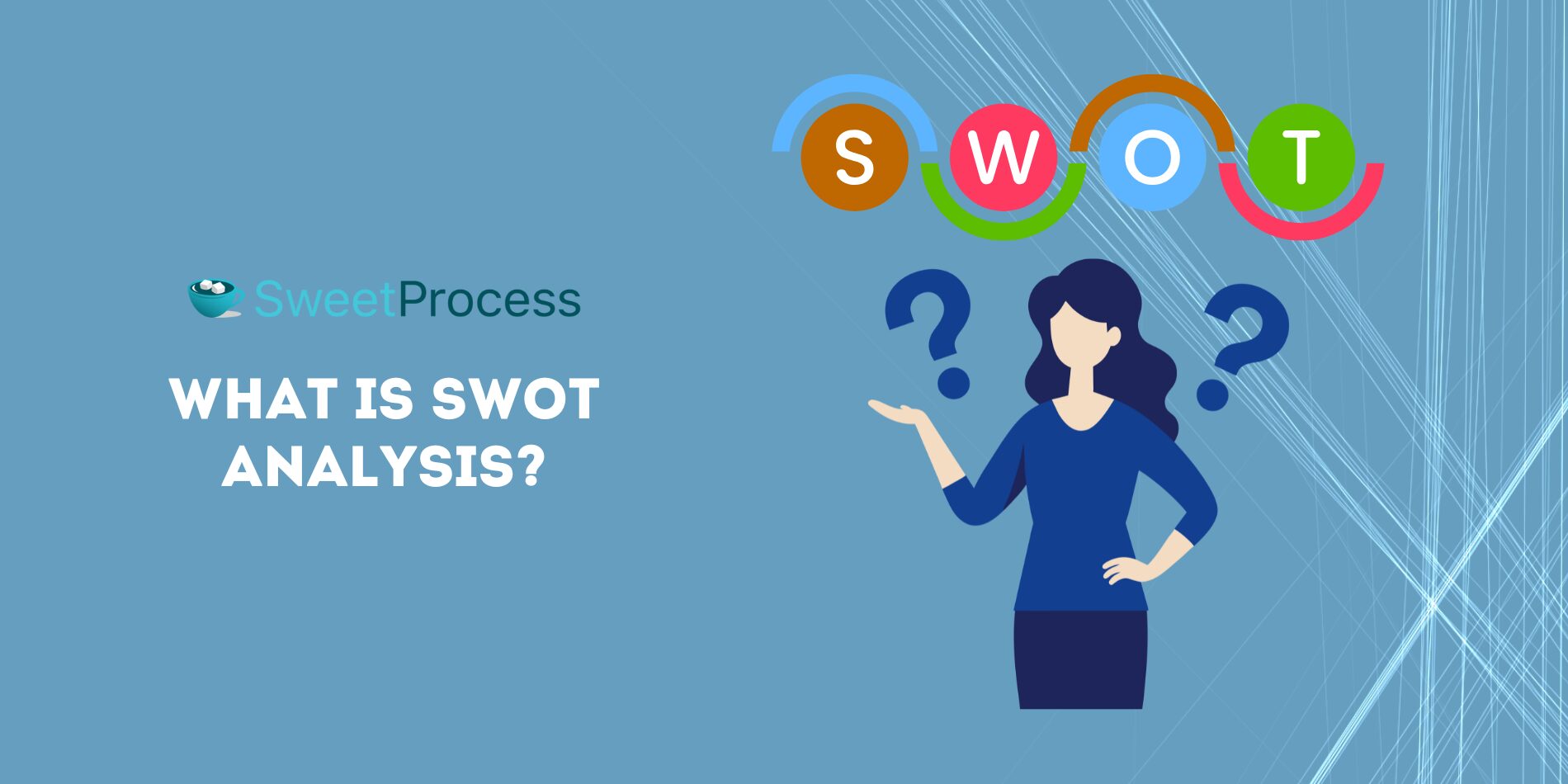
The acronym SWOT stands for strengths, weaknesses, opportunities, and threats—four critical areas that determine how well your business performs internally and externally.
SWOT analysis is a strategic planning method that helps you evaluate internal and external factors that could impact your business. Examining these four areas allows you to comprehensively understand your current situation and make smarter, more informed decisions.
It’s critical in strategic management, helping you align your objectives with actionable insights.
Components of a SWOT Analysis
Each element—strengths, weaknesses, opportunities, and threats—offers a unique perspective on your business.
Let’s break them down:
Strengths
Strengths are the internal factors that give your business a competitive edge. These include tangible assets such as advanced technology, financial stability, or a prime location. They can also include intangible advantages like a strong brand reputation, a skilled workforce, or a loyal customer base.
Weaknesses
Weaknesses are internal factors that limit your business’s performance. They are areas where you struggle or fall short; if not addressed, they can hold you back. Weaknesses can stem from resource limitations, operational inefficiencies, or gaps in expertise.
Opportunities
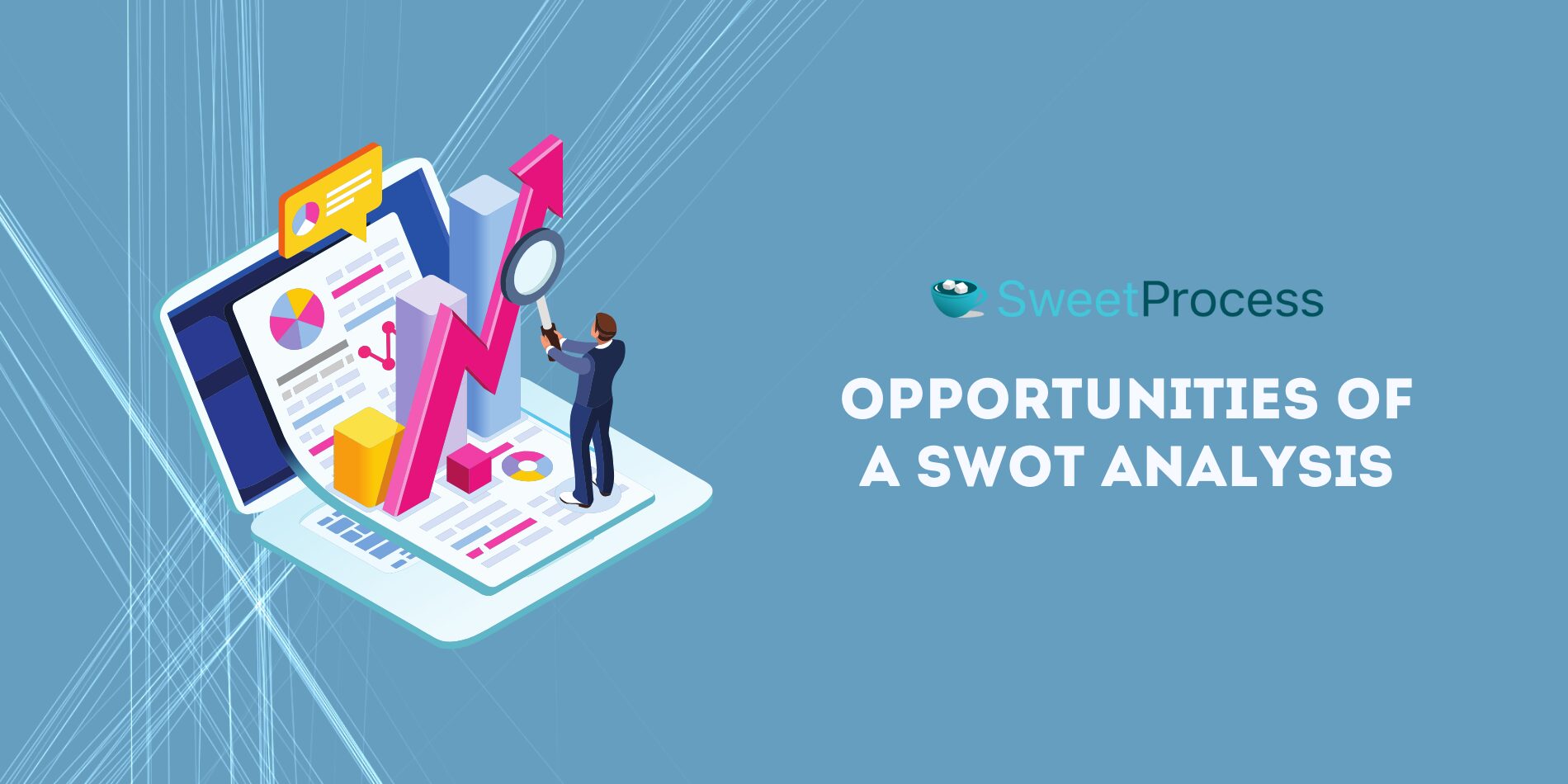
Opportunities are external factors in the market or industry that your business can exploit for growth. These are trends, changes, or gaps in the market that you can leverage to your benefit.
Threats
Threats are external challenges that could negatively impact your business. These could range from rising competition and economic downturns to regulatory changes or shifts in consumer behavior.
A SWOT analysis is a great way to uncover insights, but the real value comes from organizing those insights and turning them into action, a key to effective strategic planning.
SweetProcess helps you structure your findings, assign tasks to your team, and track progress—all in one place. Its collaborative tools ensure that your SWOT analysis translates into clear strategies everyone understands and follows.
Sign up for SweetProcess today and create a clear, actionable plan from your SWOT insights.
How to Conduct a SWOT Analysis for Your Business (With Examples)
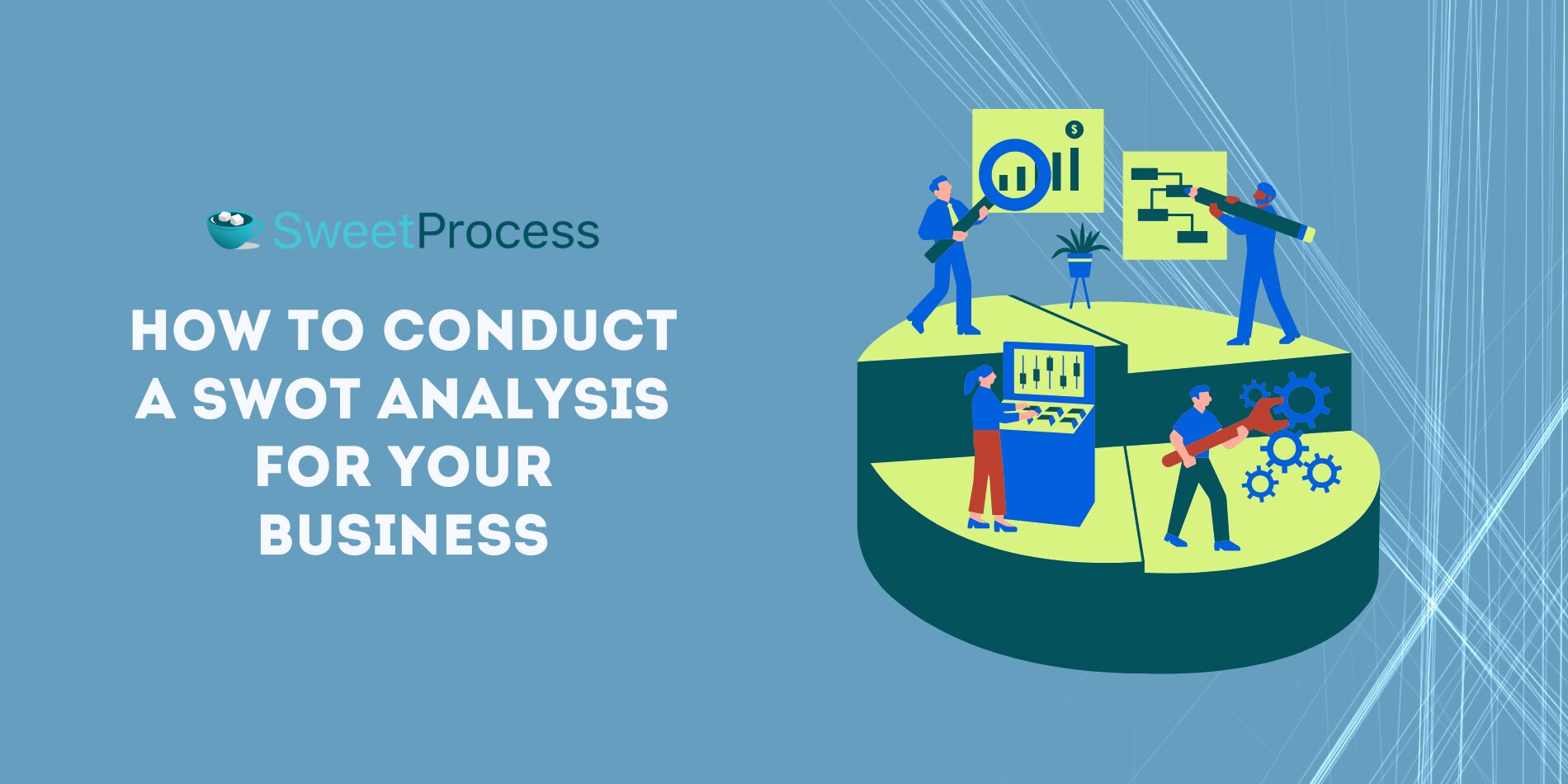
Conducting a SWOT analysis is a thoughtful and detailed process. To truly benefit, each step must be executed thoroughly, with clear insights and actionable strategies as the end goal. Below, we’ll explain each step in depth to help you understand and apply the process effectively.
Determine Your Objectives
Without a clear objective, the SWOT analysis risks becoming a collection of random observations rather than a strategic tool to guide business decisions.
Your objective answers the question: Why are we conducting this SWOT analysis? It aligns the entire process with a specific goal.
Gather Your Team Together
SWOT analysis thrives on collaboration. Each person in your business brings a unique perspective based on their role, experience, and expertise.
Collaboration ensures that your SWOT analysis reflects your organization’s collective understanding, leading to a more comprehensive and actionable result.
Identify Your Weaknesses
Weaknesses are the internal factors that limit your business’s ability to perform at its best. These could include resource constraints, process inefficiencies, skill gaps, or even misaligned goals.
Weaknesses are not just about what’s “wrong” but about identifying aspects of your business that could perform better with the right focus and resources.
Compare your business with competitors to see where you fall short.
Consider Your Opportunities
Unlike strengths and weaknesses, which are internal, opportunities exist outside your organization. They often arise from changes in the market, consumer behavior, technology, or regulations.
Opportunities open doors to new markets, increase customer satisfaction and boost profitability.
For instance, emerging trends in your industry may align with your strengths, presenting a chance to expand your market presence. Additionally, identifying underserved customer segments can open new revenue streams and enhance customer satisfaction. Technological advancements can also create possibilities for improving efficiency, launching innovative products, or optimizing your operations.
Contemplate Your Threats
These are the factors you don’t control but must prepare for to safeguard your operations, protect your market share, and maintain long-term growth.
Recognizing these challenges early lets you prepare effectively. You can mitigate potential risks before they escalate and develop contingency plans to minimize damage.
When you address threats head-on, you give your business the flexibility and resilience to handle change and keep moving forward.
Refine Findings

An unorganized SWOT analysis can feel overwhelming, with too many points competing for attention. Refining helps you eliminate this redundancy, prioritize impactful insights, and align everything with your objectives.
Refining findings ensures that your SWOT analysis becomes a valuable tool for strategic planning. When integrated into your operational plan, these insights help bridge the gap between analysis and execution, ensuring that your strategies are both effective and actionable.
For example, Forest Incentives identified from their SWOT analysis that inefficiencies in their documentation processes were a weakness. By adopting SweetProcess, they centralized their knowledge base, streamlined workflows, and improved team collaboration, effectively turning insights from their analysis into actionable strategies.
Gather Resources
After refining your SWOT analysis, the next step is to gather the resources necessary to turn your findings into actionable strategies.
This step ensures you have everything you need to address weaknesses, leverage strengths, seize opportunities, and mitigate threats.
Revisit your findings to identify specific resource requirements. Link each priority action to the type of resource it needs. If your analysis reveals a weakness in customer support, consider hiring additional support staff or investing in customer service software.
Compile Ideas
Compiling your ideas ensures that your SWOT analysis transitions from a brainstorming session into a practical tool.
The most common way to compile your findings is through a SWOT matrix. A SWOT matrix is a simple four-quadrant grid that visually organizes strengths, weaknesses, opportunities, and threats.
This step bridges the gap between analysis and execution, empowering your business to move forward with clarity and purpose.
Develop Strategies
A SWOT analysis without actionable strategies is simply a list of observations. You make your SWOT analysis practical and impactful by linking your findings to strategic actions.
To develop strategies, start by identifying how your strengths can be used to capitalize on opportunities. This alignment allows you to create strategies that leverage your internal advantages to achieve external gains.
Then, look at opportunities that your weaknesses might hinder. Develop strategies to overcome these limitations so you can fully exploit external possibilities.
Take Action
Translate each strategy into specific, measurable tasks. Assign responsibilities and set deadlines to ensure accountability. For example, if the strategy is to improve your online presence, tasks might include redesigning your website, creating social media campaigns, and hiring a digital marketing specialist.
To simplify your SWOT analysis, you can use this SWOT analysis template to get started with a structured approach.
With SweetProcess, you document your strategies, assign responsibilities, and monitor progress—all in one easy-to-use platform.
How to Enhance Your Company’s SWOT Analysis Using SweetProcess
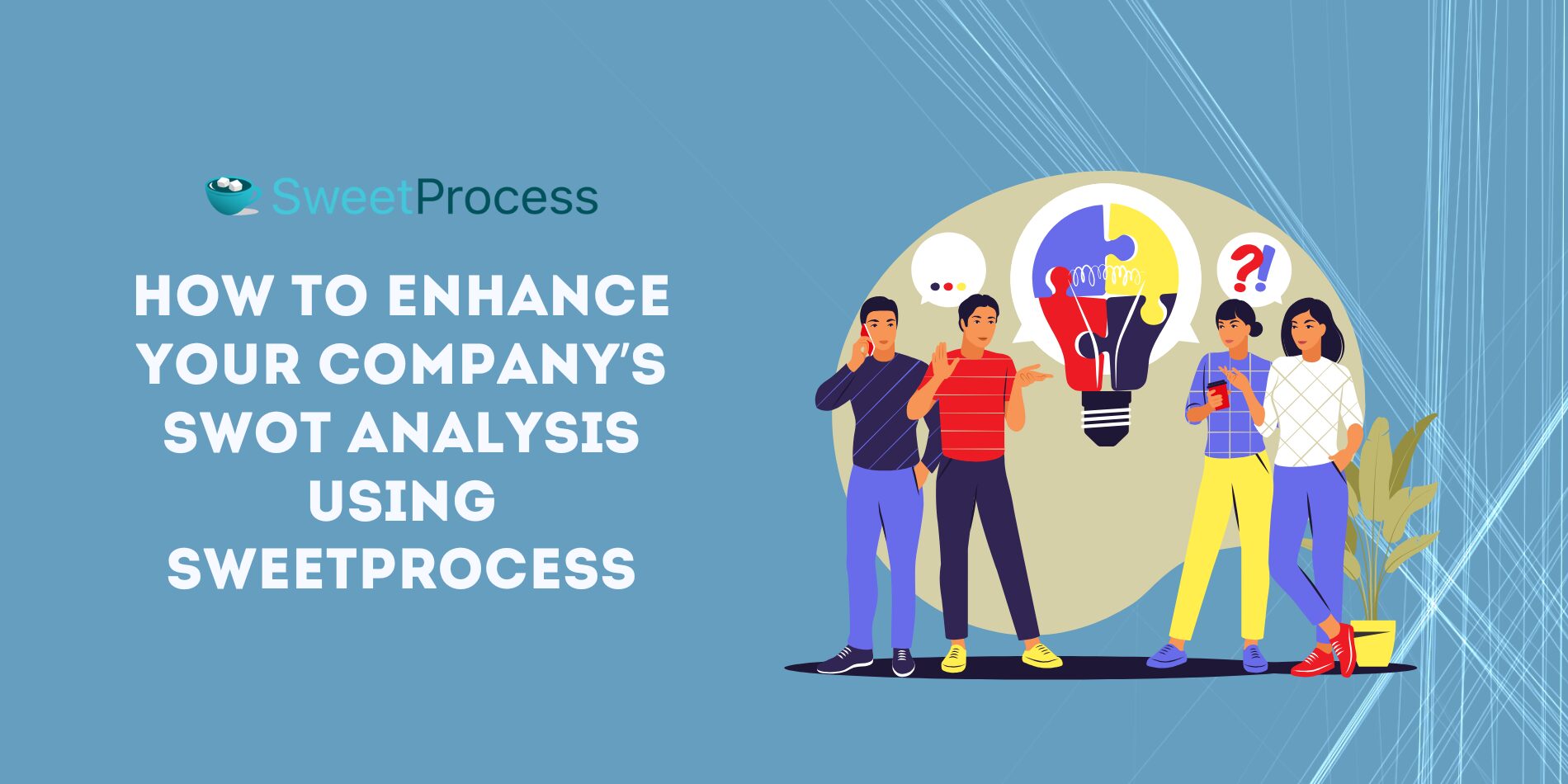
SweetProcess provides a practical, user-friendly system to streamline the process. Our platform simplifies complex workflows by breaking them into clear, repeatable steps.
It gives you a structured system where you can:
- Document every step of the SWOT analysis process
- Assign tasks to specific team members for accountability
- Store findings in an easily accessible, centralized repository
- Track updates and revisions to refine your strategies over time
- Do business process analysis, enabling you to align your SWOT analysis with actionable workflows
Let’s dive into how you can leverage SweetProcess to streamline your SWOT analysis and make it a core driver of your strategic planning.
Create a Business Process
The first step in using SweetProcess for your SWOT analysis is to create a business process that outlines the entire workflow.
Here’s how to document your SWOT analysis process step by step:
1. Navigate to the Processes Tab
Start by clicking the “Processes” tab in SweetProcess. This is your hub for creating and managing all business workflows.

2. Click “Create Process”
Click the “Create Process” button in the top-right corner to open a new process documentation template. This will open a form where you can start defining your process.

3. Enter the Process Title
- Provide a clear and descriptive title for your process. For example: Conducting a SWOT Analysis for Quarterly Strategic Planning.
- This ensures your team knows exactly what this process is for.

4. Assign the Process to Relevant Teams
Select the departments or teams responsible for contributing to the SWOT analysis.

5. Add a Description
After naming your process and assigning it to a team, click “Continue.” Next, give it a description. Just below the process title, click “Add a Description.” Clearly define the purpose and scope of the SWOT analysis process. You can also add a tag. Tags help you quickly find the process later by filtering using a tag. Then click “Finished Editing” to save the tags and description.
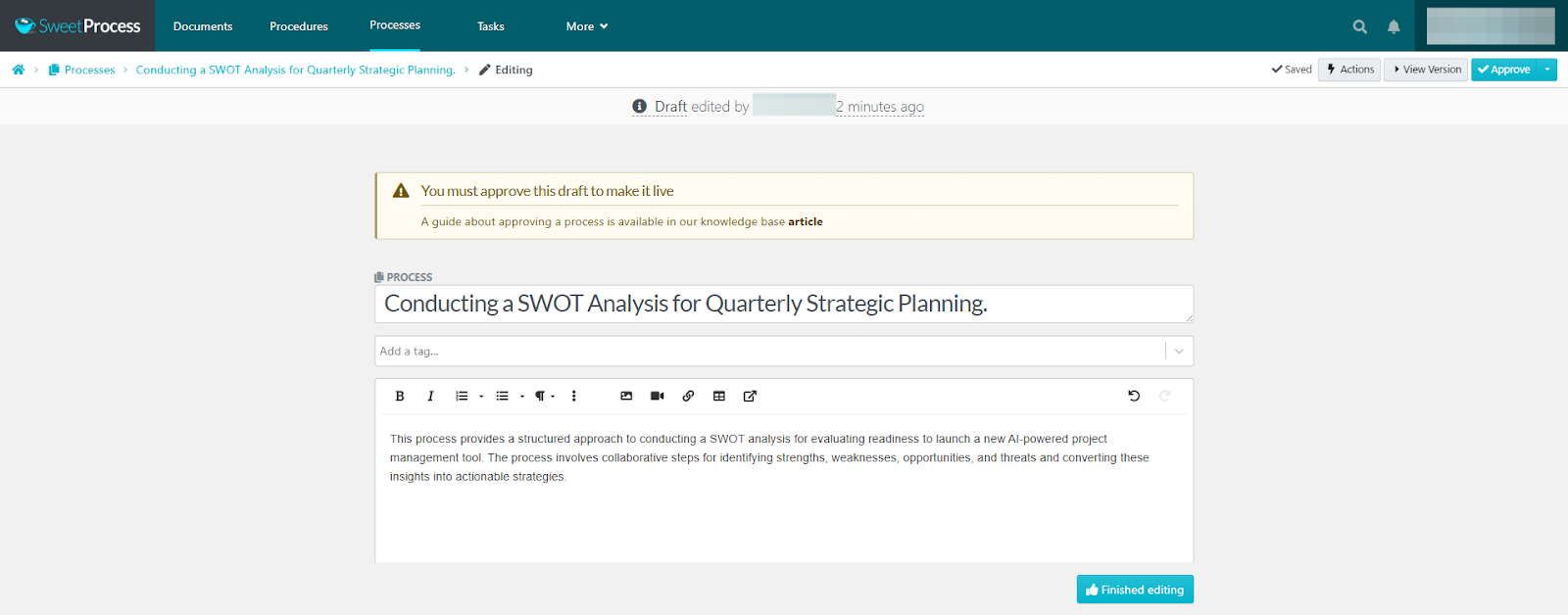
6. Click the “Add Step” button to start building the process.
- You will see three options:
- Procedure
- Decision
- End Step
Example: Adding Procedure 1: Prepare for the SWOT Analysis
- Click “Add Step” and select “Procedure.”
- If the procedure hasn’t already been created, you’ll need to create it. (See below for instructions on how to create a procedure.)
- Once the procedure is available, select “Procedure 1: Prepare for the SWOT Analysis” from the list.
- Repeat this process to add additional steps (e.g., brainstorming categories, refining findings).
- At the end of the process, add an End Step to signify completion.
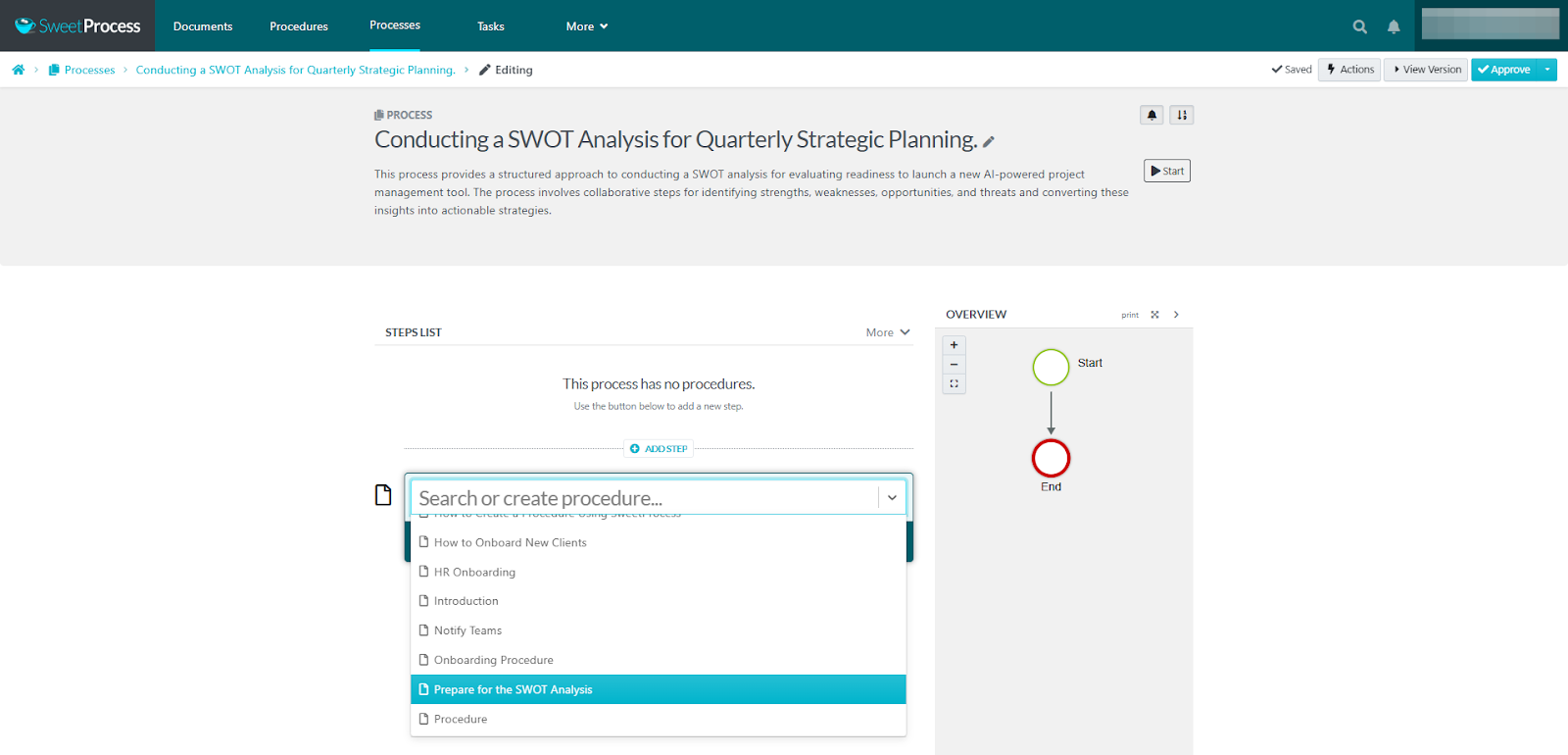
How to Create a Procedure
If your procedure doesn’t already exist, follow these steps to create one:
1. Navigate to the “Procedures” Tab
Click on the “Procedures” tab in SweetProcess to begin documenting the first procedure.
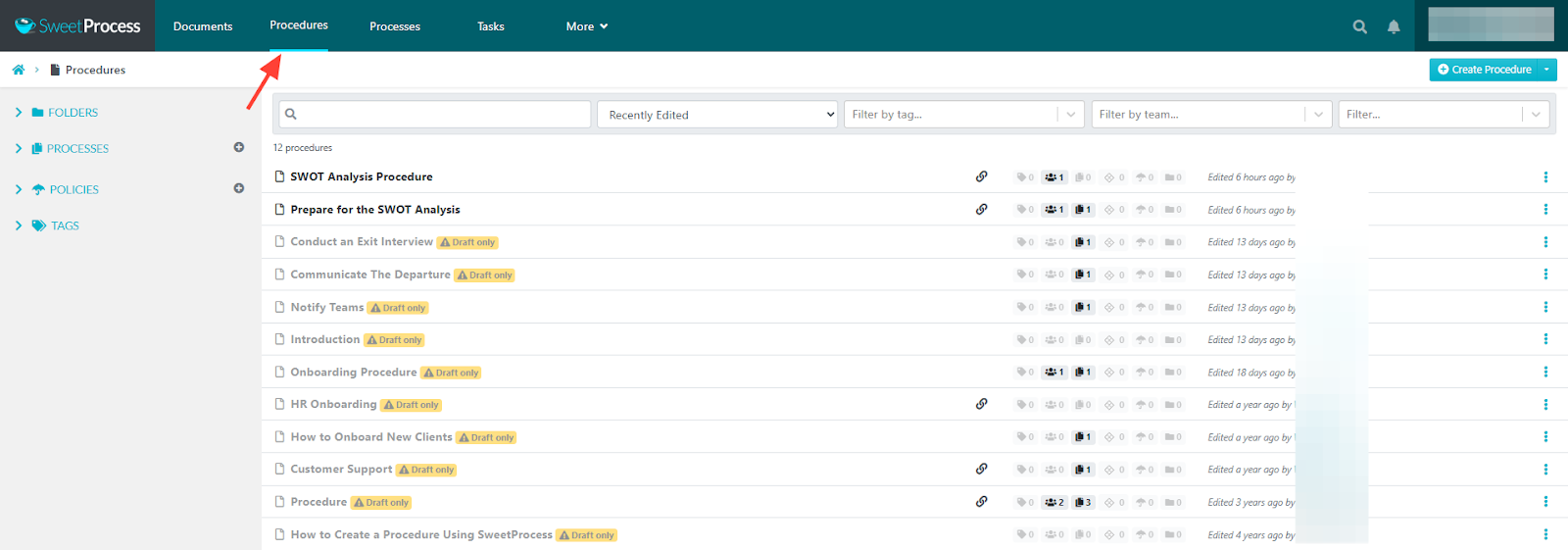
2. Click “Create Procedure”
Click the “Create Procedure” button in the top-right corner of the page.
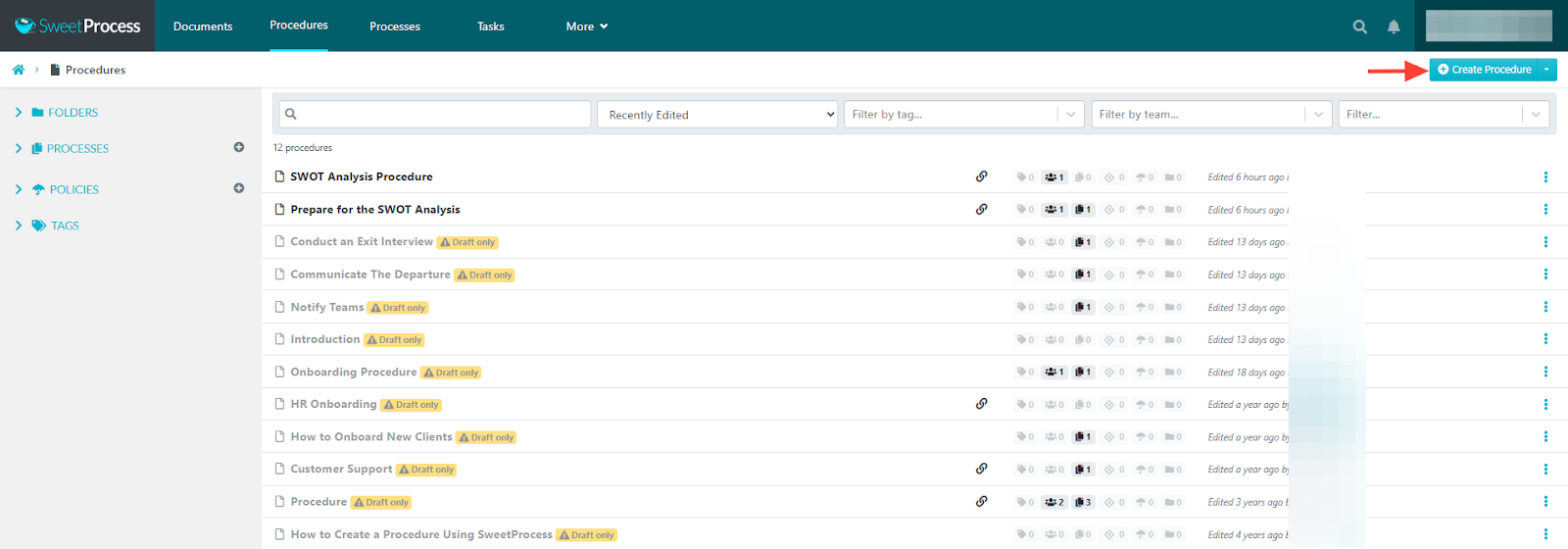
3. Enter the Procedure Title
Example title: “Prepare for the SWOT Analysis”
4. Assign the Procedure to Teams
Add the procedure to relevant teams just as you did with the process.
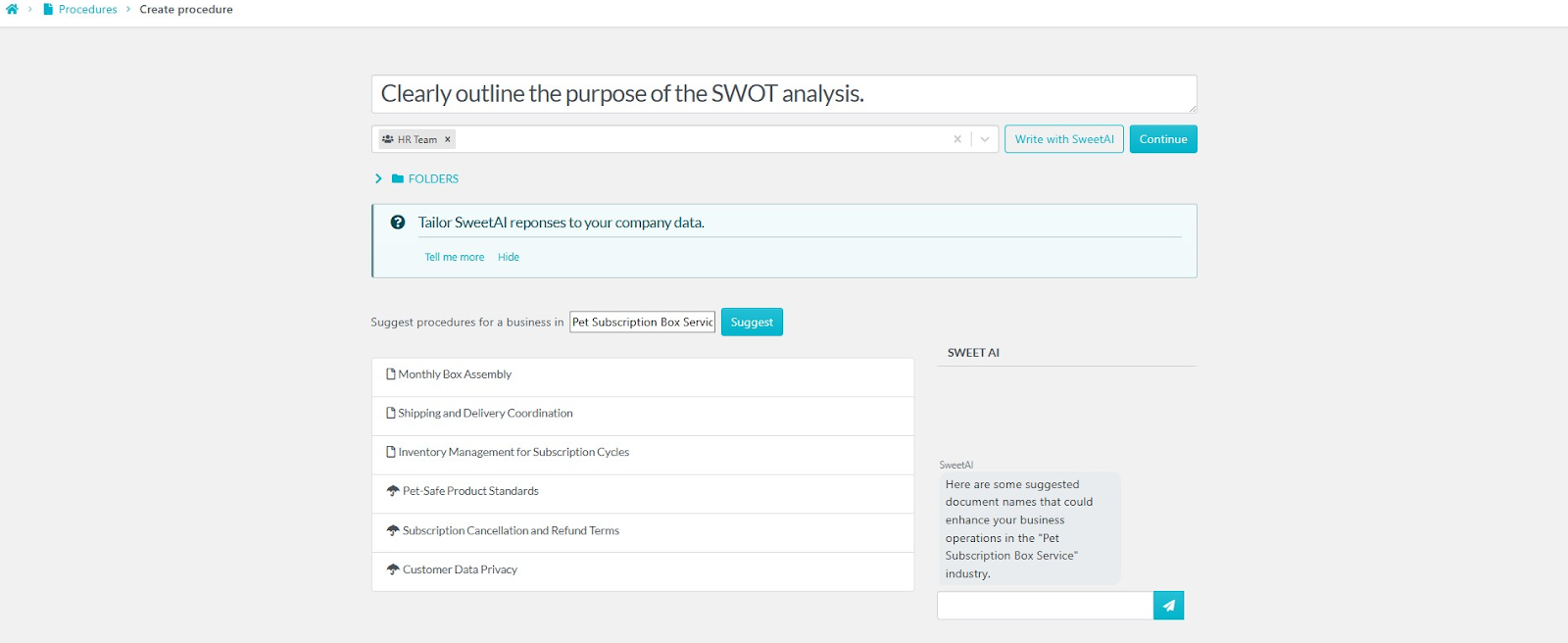
5. Add a Description
Click on the procedure title and add a detailed description of what this procedure entails.
6. Add Steps to the Procedure
Break down the procedure into individual steps. Each step should be clear, concise, and actionable. To add a step, click on the “Add Step” button. Enter the details for each step, including instructions, examples, or visuals.
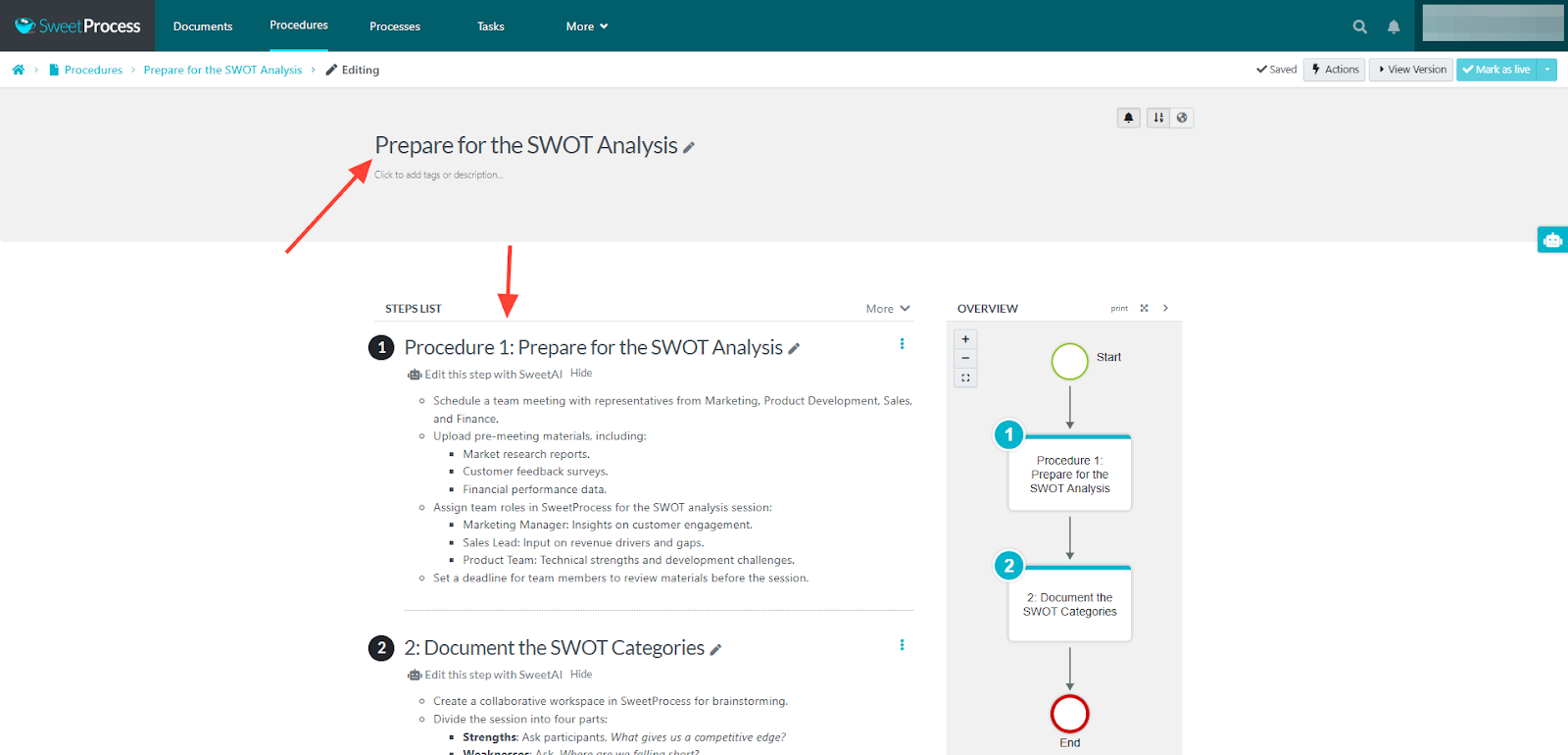
Note: You can write the procedure using our AI, the SweetAI feature. If you choose AI, you just need to add the title as a prompt and click “Write with SweetAI.” Give it a few seconds. The AI will automatically generate the procedure’s steps, flowchart, and descriptions.
Once you’ve added all the steps, review the procedure to ensure it’s clear and complete. Click the “Approve” button on the top-right corner to save your work. You must approve this draft to make it live.
View the Version History of a Process
One of SweetProcess’s standout features is the ability to track and view the version history of a process. This feature allows you to monitor changes, revisit previous iterations, and ensure the analysis reflects accurate and up-to-date insights.
Here’s how to view the version history of a process step-by-step.
Step 1: Access the Process
- Navigate to the process you want to review.
- Open the process details page by clicking its title in the processes tab.

Step 2: Click the Clock Icon
- On the process page, locate the clock icon in the top menu.
- This icon represents the version history feature.
Step 3: Open the Version History Sidebar
- Click the clock icon to open the version history sidebar.
- A menu will appear listing all versions of the process, including the current version and any past iterations.
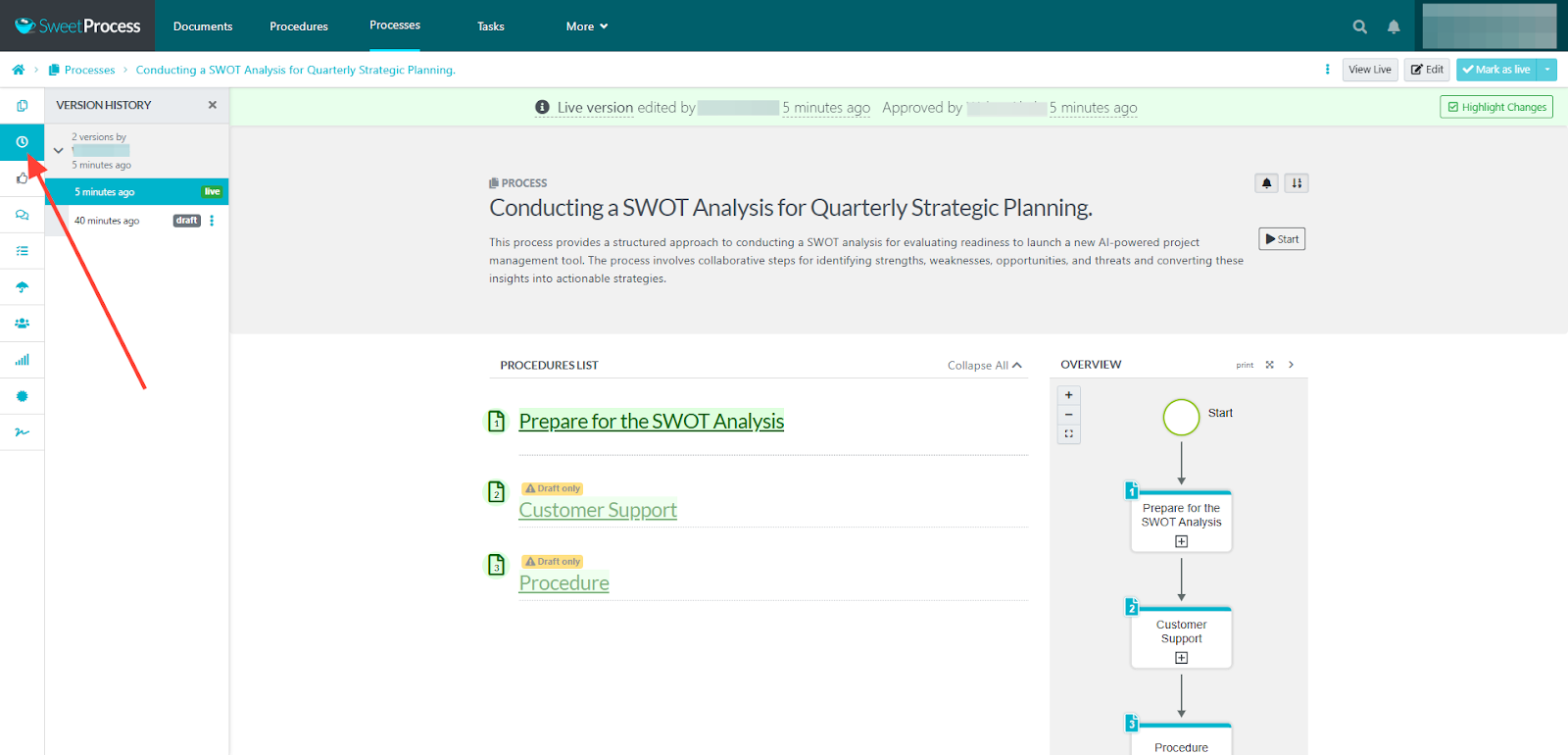
Step 4: Select a Version
- From the sidebar, click on the version you wish to review.
- This action will load the selected version, allowing you to compare it with the current version.
Step 5: Review and Compare
- Once you’ve opened the version, examine the content to understand what changes were made.
- Look for additions, deletions, or modifications in steps or procedures.
- If needed, you can take notes or screenshot sections for reference.
Step 6: Revert if Necessary
- If you identify that a past version is more accurate or useful, you can choose to revert the process back to that version. (Note: Reverting may require permissions depending on your role in SweetProcess.)
Let’s say you conduct quarterly SWOT analyses. During one session, the team identifies “strong client retention” as a strength. In the next quarter, they refined this finding to “client retention increased by 10% due to new loyalty programs.”
Using the version history feature:
- They can review how their SWOT findings have evolved over time.
- Revisit earlier iterations to see how strategies tied to client retention were developed.
- Use these insights to refine their approach for future analyses.
Collaborate with Team Members
SweetProcess enhances team collaboration by allowing members to leave comments, share feedback, and suggest improvements directly within procedures. This streamlined communication ensures that every voice is heard and every detail is considered during the SWOT analysis process.
Here’s how to collaborate using SweetProcess:
Step 1: Open the Procedure
- Navigate to the specific procedure within your SWOT analysis process by clicking on the Procedures tab on the top menu and then clicking the procedure you want to collaborate on to open it.
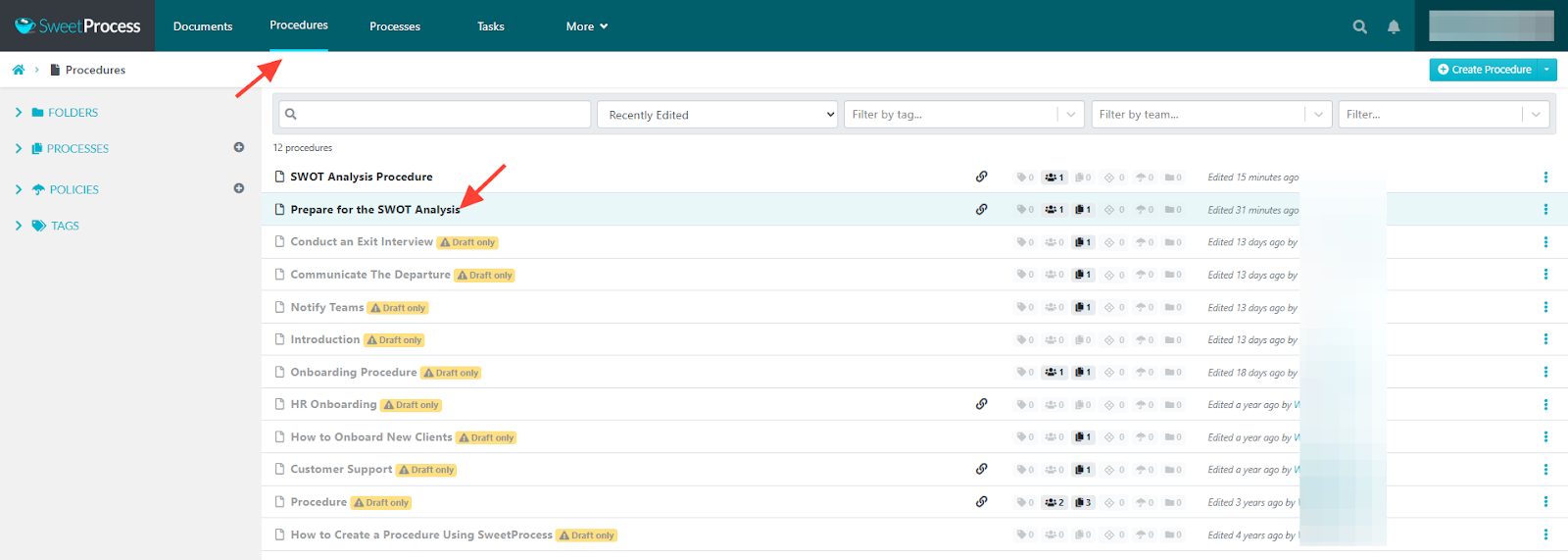
Step 2: Access the Comment Feature
- Click on the comment bubble icon located on the procedure page.
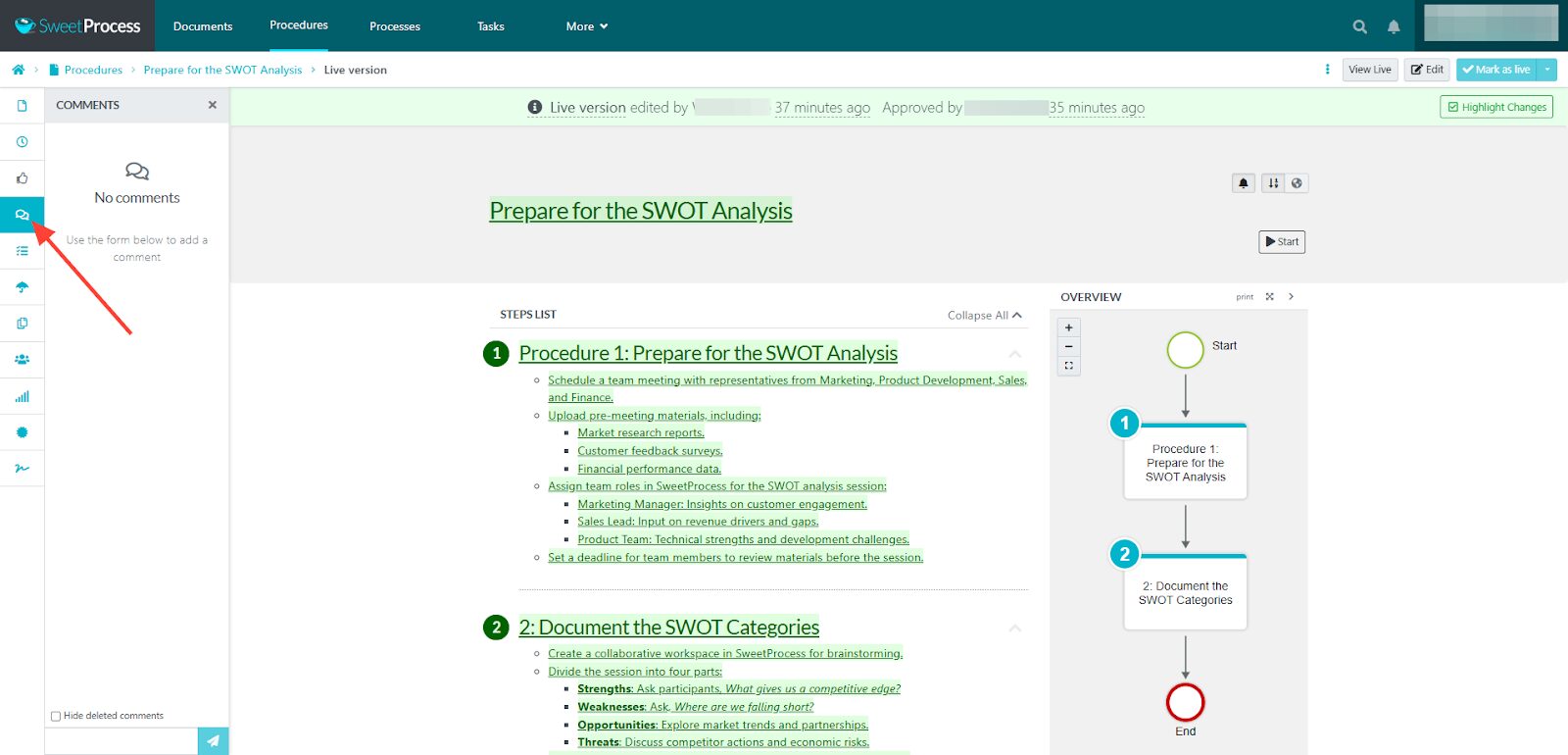
Step 3: Leave a Comment
- In the comment box, type your feedback, suggestion, or improvement.
Step 4: Send the Comment
- Click on the paper plane icon to submit your comment.
- Once sent, your comment will be visible to all managers of the procedure and anyone who has previously commented.
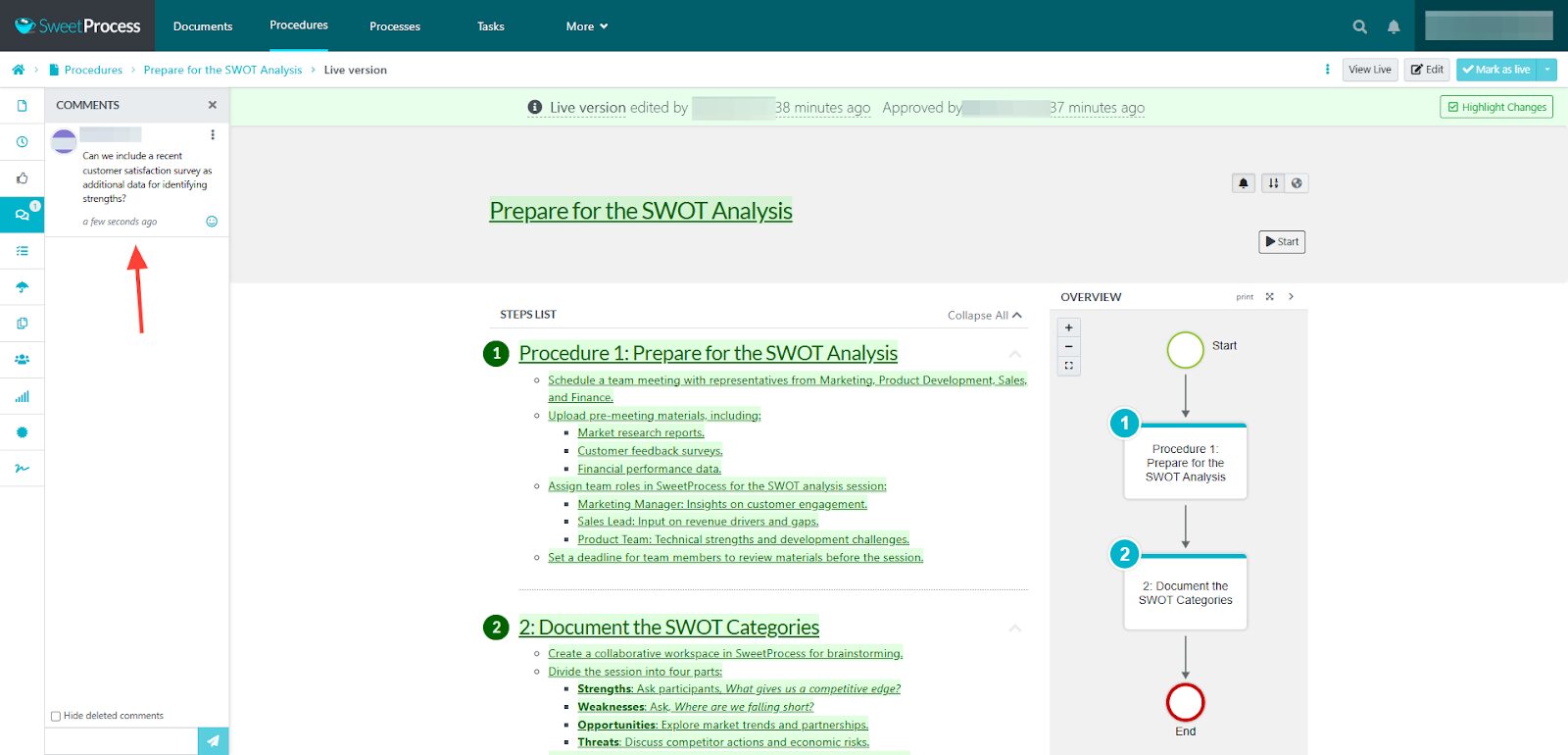
Step 5: Respond to Feedback
- If you receive a comment notification by email, you can:
- Respond directly in SweetProcess.
- Reply to the email, which will automatically add your response as a new comment.
Collaborating with your team using SweetProcess transforms SWOT analysis into a dynamic, inclusive, and actionable exercise. Every team member can contribute, ensuring the analysis is well-rounded and ready to drive meaningful strategies.
5 SWOT Analysis Examples to Learn From
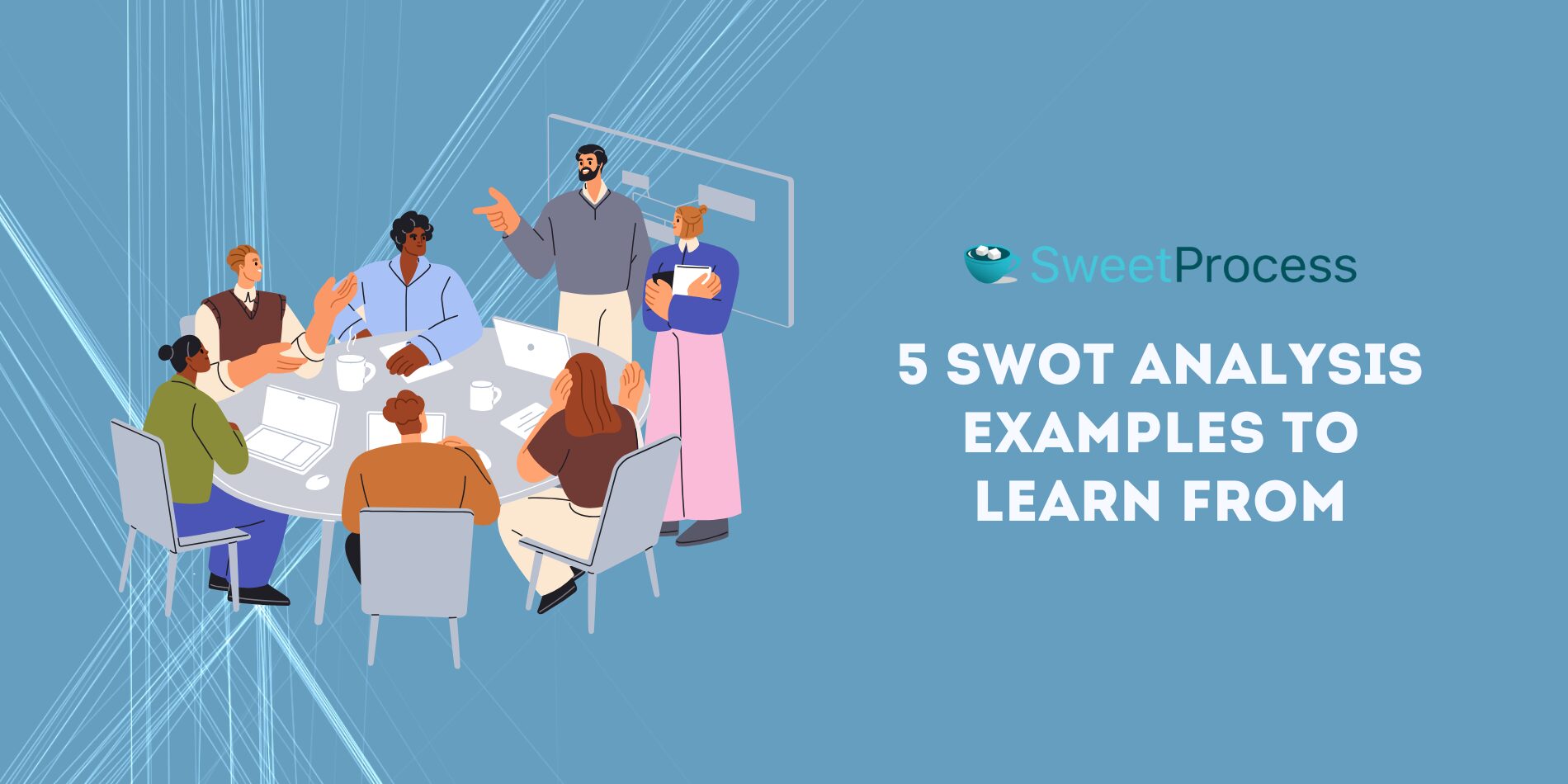
SWOT analyses help companies understand their internal strengths and weaknesses while exploring external opportunities and threats.
To see how powerful this tool can be, let’s examine five well-known companies and how they have used SWOT analysis to navigate challenges and opportunities.
1. Apple Inc.
Apple recognized its strengths in brand loyalty and innovation and used this as the foundation for its strategy. By identifying its over-reliance on the iPhone (a weakness), Apple expanded its services division, launching Apple Music, Apple TV+, and iCloud.
Outcome
- Diversified Revenue Streams: Apple’s services segment generated over 24.97 billion US dollars in services revenue in the fourth quarter of 2024.
- Enhanced Customer Retention: The interconnected ecosystem of hardware and services keeps customers loyal and engaged.
2. Peloton
Peloton’s SWOT analysis example revealed high equipment costs as a significant barrier to entry. To address this, the company:
- Introduced financing options to address the barrier of high equipment costs.
- Launched a Corporate Wellness Program to tap into new market segments.
- Added a rental program to their Corporate Wellness Benefits, allowing employees to try equipment without a long-term commitment.
Outcome
- Broader Customer Base: Financing options made Peloton products available to a wider audience.
- Increased Revenue Streams: Partnerships with companies for employee wellness programs opened new markets. As of September 30, 2024, Peloton generated approximately $50.1 million in revenue from international markets, an increase from $46.7 million in the same period last year.
3. Disney
Disney’s diverse brand portfolio (Marvel, Star Wars, Pixar) and its transition into streaming with Disney+ demonstrate its adaptability. However, high operational costs and seasonal revenue dependence are notable challenges.
Based on its SWOT analysis, Disney has taken several strategic actions:
- Launched Disney+ and expanded its streaming services, including the integration of ESPN+ content within Disney.
- Invested heavily in content creation and acquisition, such as the $71.3 billion purchase of 21st Century Fox to bolster its content library.
Outcome
- Broader Content Offering: The acquisition of 21st Century Fox and the launch of Disney+ have significantly expanded Disney’s content library and reach.
- Increased Revenue Streams: The company’s focus on streaming and international expansion has opened up new revenue opportunities. Disney reported increased revenues of $22.1 billion for Q2 2024, up from $21.8 billion in the prior-year quarter.
4. Salesforce
Salesforce’s dominance in the CRM market, with approximately 23% market share, is a key strength. The company’s comprehensive product portfolio, covering sales, service, marketing, and commerce, provides integrated solutions for businesses, but challenges include steep learning curves and intense competition. The company’s SWOT analysis guided its focus on innovation and international growth.
What They Did
Based on its SWOT analysis, Salesforce has taken several strategic actions:
- Invested heavily in AI capabilities and the Einstein platform to enhance automation across its product portfolio.
- Pursued strategic acquisitions and partnerships, such as the integration with Google Analytics 360 and G Suite, to enhance its offerings.
Outcome
- Improved Financial Performance: Despite slowing revenue growth, Salesforce has demonstrated strong margin improvement. The company’s non-GAAP operating margin reached 33.7% in the latest quarter, exceeding analyst expectations.
- Expanded Market Reach: Salesforce’s focus on international expansion and industry-specific solutions has helped broaden its customer base and tap into new markets.
5. Starbucks
Starbucks thrives on its strong brand and customer loyalty but faces rising competition and dependency on the US market. Its SWOT analysis prompted strategic initiatives to enhance customer experience and global growth.
What They Did
Based on its SWOT analysis, Starbucks has implemented several strategic initiatives:
- Streamlined mobile ordering to improve efficiency and customer experience.
- Invested in digital capabilities, including its rewards program and mobile app, to enhance customer loyalty and engagement.
Outcome
- Improved Customer Experience: Streamlining mobile orders and simplifying the menu have improved customer satisfaction by speeding up service.
- Global Expansion: International revenue increased to $50.1 million in Q2 2024, up from $46.7 million in the same period of the previous year.
These SWOT analyses of industry leaders offer valuable insights into strategic decision-making and business growth. However, implementing these strategies effectively requires the right tools.
Take the example of Stone & Wood Brewing Company. They identified weaknesses in their operational processes and streamlined them by adopting SweetProcess. This shift not only simplified their employee onboarding and training but also ensured real-time updates to procedures, improved compliance with ISO standards, and boosted overall efficiency.
SweetProcess made it easy for Stone & Wood to turn their insights into action—and it can do the same for your business.
11 Benefits of SWOT Analysis for a Small Business
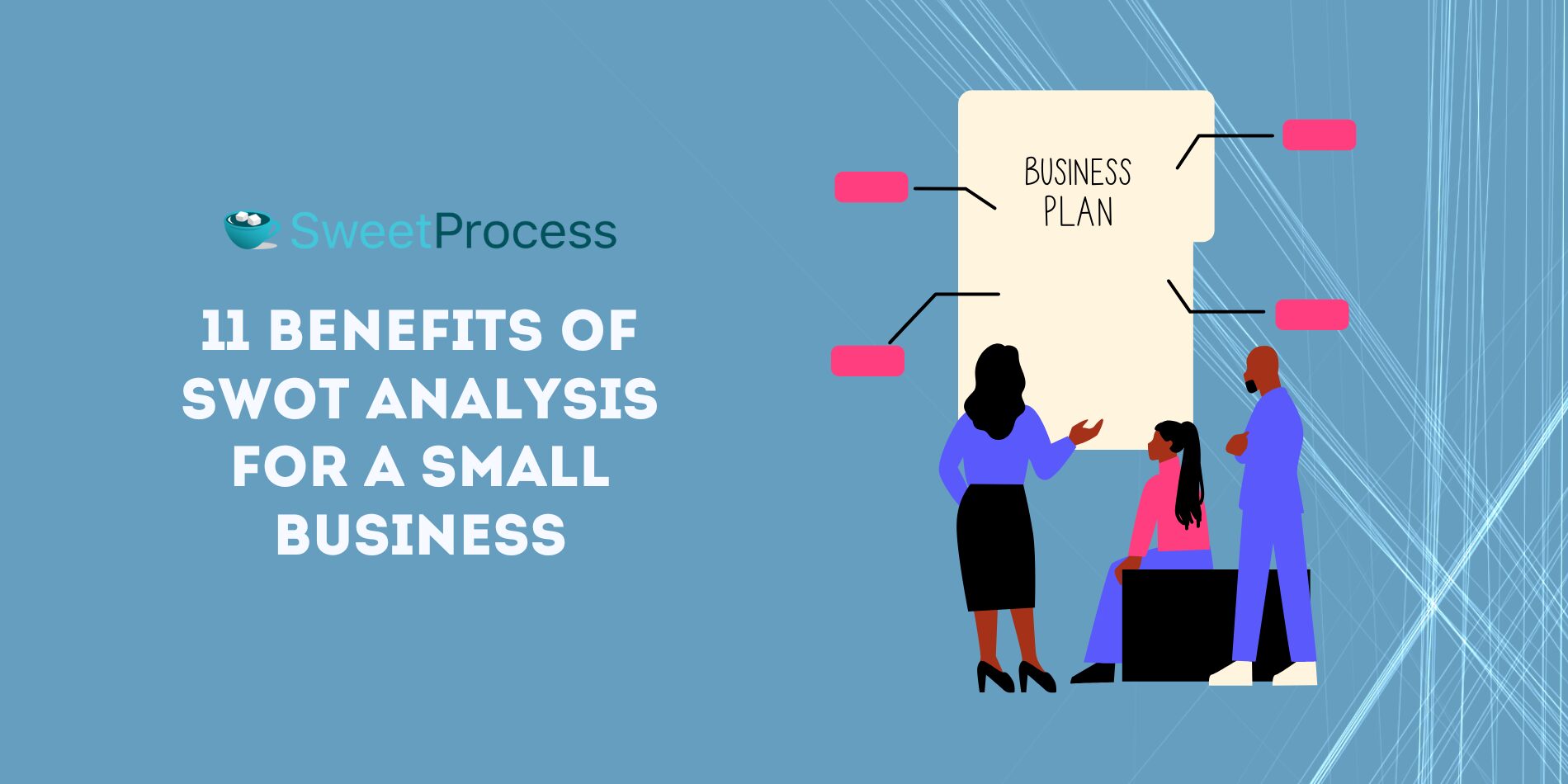
Below, we explore 11 key benefits that make SWOT analysis a must-have tool for small businesses.
1. Simplicity and Ease of Use
SWOT analysis is straightforward, making it accessible to businesses of all sizes. Unlike complex strategic tools, SWOT analysis requires minimal training or resources.
2. Encourages Strategic Thinking
SWOT analysis forces businesses to think critically about their goals, challenges, and environment. By evaluating internal and external factors, teams can align their efforts with the bigger picture and develop strategies that support long-term objectives.
3. Promotes Collaboration
SWOT analysis is most effective when done collaboratively. It brings together team members from different departments or backgrounds, encouraging diverse perspectives and fostering a shared understanding of the company’s challenges and opportunities.
4. Develop Tangible Roadmaps
One of the biggest benefits of SWOT analysis is its ability to translate insights into actionable strategies. By connecting strengths with opportunities and addressing weaknesses to mitigate threats, businesses can create clear roadmaps for success.
5. Improve Specific Campaigns and Projects
SWOT analysis isn’t just for big-picture planning—it can also be used to refine specific campaigns or projects. By identifying potential challenges and opportunities upfront, businesses can maximize success while minimizing risks.
6. Makes Complex Problems More Manageable
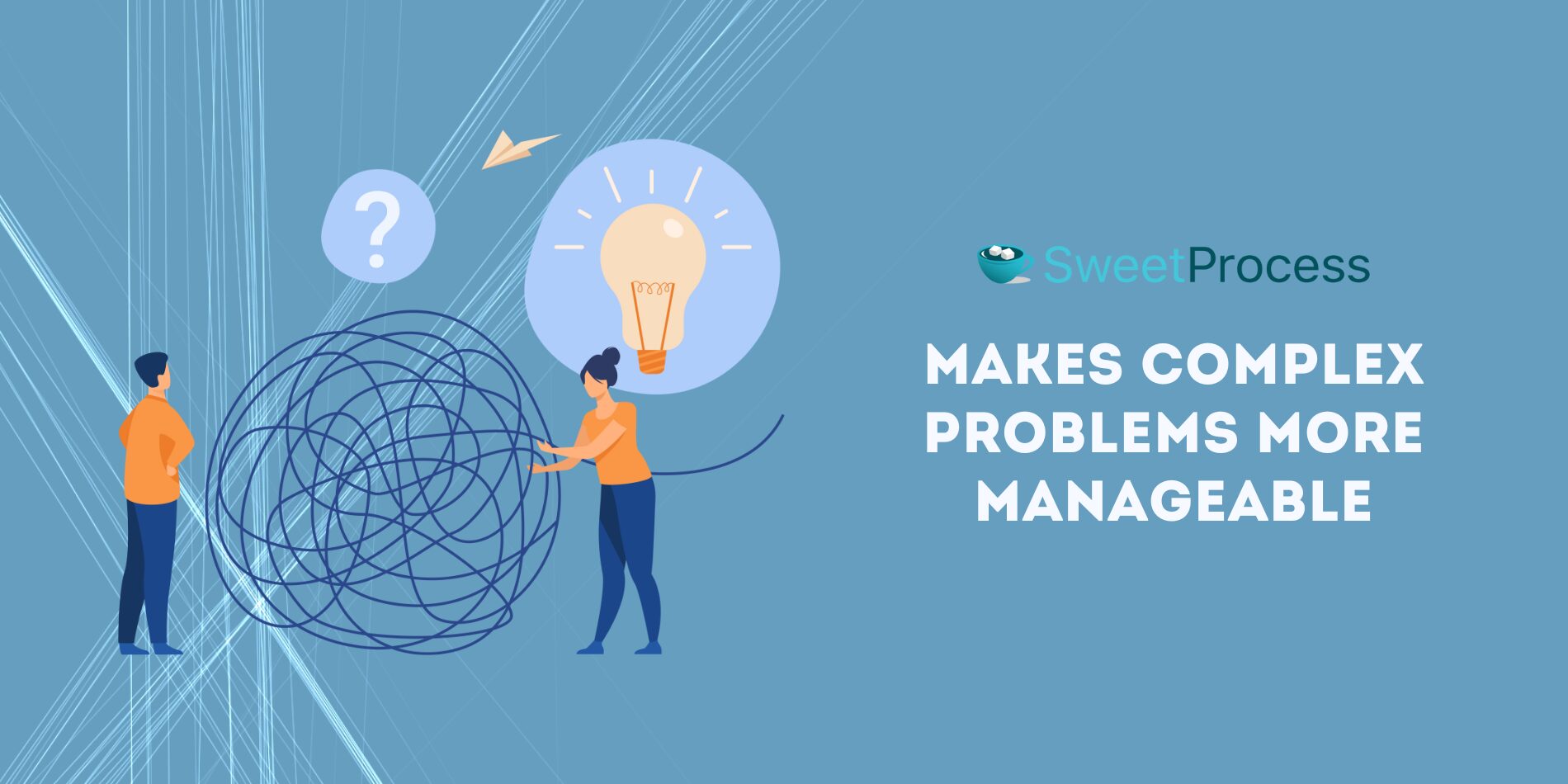
By breaking down challenges into internal (strengths and weaknesses) and external (opportunities and threats) categories, SWOT analysis makes even the most daunting problems feel more manageable. This clarity helps teams focus on what they can control and prioritize effectively.
7. Applicable to Almost Every Business Question
SWOT analysis is incredibly flexible and can be applied to virtually any business scenario, from exploring new markets to evaluating partnerships. Its adaptability makes it an indispensable tool for small businesses.
8. Leverages Different Data Sources
SWOT analysis encourages businesses to use various data sources, from financial reports to customer feedback. This integration of quantitative and qualitative data ensures that insights are well-rounded and actionable.
9. Not Overly Costly to Operate
For small businesses with limited budgets, SWOT analysis is an affordable option. It doesn’t require expensive tools or software—just a collaborative effort and a structured approach.
10. Adaptation to Various Contexts
SWOT analysis can be tailored to different contexts, whether it’s used for strategic planning, operational improvements, or product launches. Its versatility allows small businesses to adapt it to their unique needs.
11. Get a Bird’s Eye View
SWOT analysis provides a high-level overview of a business’s position, helping decision-makers see the bigger picture. This perspective is invaluable for setting priorities and aligning resources with the company’s goals.
When Should You Use SWOT Analysis in Your Organization?
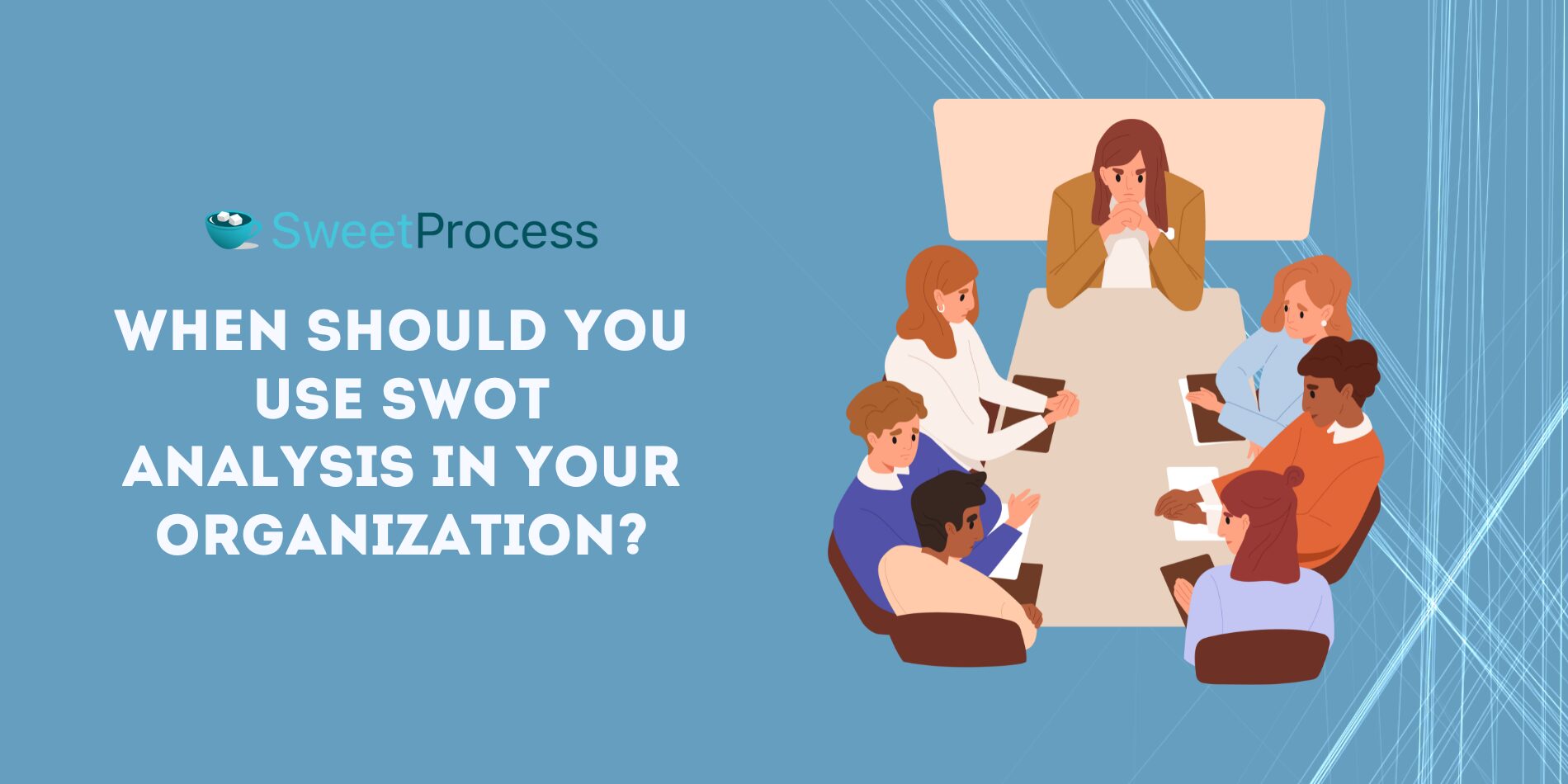
SWOT analysis is a versatile tool that can be used at various stages of your business journey, but when is the best time to conduct a SWOT analysis? Below are the key moments when SWOT analysis can add significant value to your organization.
1. Before You Implement a Large Change
A SWOT analysis can provide crucial insights when your organization is about to undergo a significant transformation, such as a rebranding campaign or a major product launch.
It helps you assess your internal readiness and external factors that might impact the change, allowing you to make informed decisions and mitigate potential risks.
2. When You Launch a New Company Initiative
A SWOT analysis can be your compass, guiding you through the planning process. It helps you identify your strengths to leverage, weaknesses to address, opportunities to seize, and threats to prepare for, ensuring a more robust and well-thought-out approach to your new venture.
3. If You Would Like to Identify Opportunities for Growth and Improvement

SWOT analysis is an excellent tool for identifying areas of growth and improvement. You can make informed decisions about where to focus your efforts by evaluating internal capabilities and external opportunities.
4. When You Want a Full Overview of Your Business Improvement
For a comprehensive understanding of your business landscape, SWOT analysis provides a holistic view of your organization’s position, considering both internal capabilities and external market factors.
5. If You Need to Identify Business Performance
When you’re struggling to meet projected performance goals or want to assess your current business viability, a SWOT analysis can help pinpoint the underlying factors.
It allows you to identify strengths that are driving success and weaknesses that might be holding you back, as well as external opportunities and threats affecting your performance.
SweetProcess can help you conduct timely and effective SWOT analyses whenever your organization needs them most. Whether you’re preparing for a major change, launching a new initiative, or seeking growth opportunities, our platform streamlines the entire process.
SWOT Analysis vs. PEST Analysis
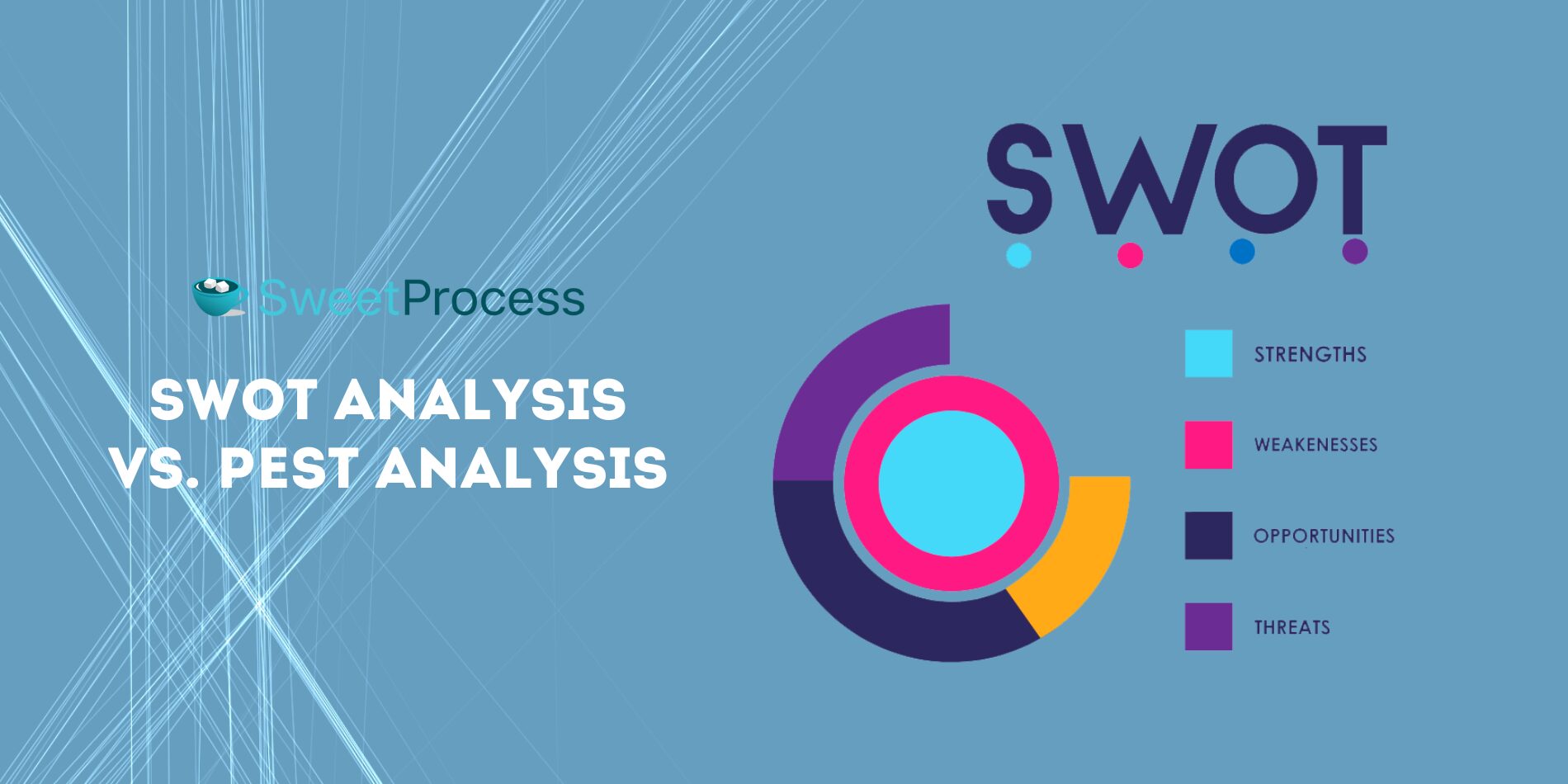
While they share some similarities, SWOT and PEST analyses focus and application differ significantly, making them complementary rather than competing methodologies.
SWOT analysis provides a comprehensive view of an organization by examining both internal and external factors. It focuses on:
- Strengths: Internal capabilities and resources that give the organization an advantage
- Weaknesses: Internal limitations or deficiencies that may hinder performance
- Opportunities: External factors or trends that the organization can potentially exploit
- Threats: External challenges or risks that could negatively impact the organization
On the other hand, PEST analysis (sometimes expanded to PESTLE) focuses solely on external macro-environmental factors that can impact an organization. These include:
- Political factors: Government policies, regulations, and political stability
- Economic factors: Economic growth, inflation rates, and market trends
- Social factors: Demographic changes, cultural shifts, and consumer behavior
- Technological factors: Technological advancements and their impact on the industry
- Legal factors: Laws and regulations affecting the business
- Environmental factors: Environmental concerns and sustainability issues
While SWOT analysis considers both internal and external factors, it may not provide as in-depth an analysis of external factors as PEST does. Conversely, PEST analysis does not consider internal organizational factors, which are crucial for strategic decision-making.
Therefore, many organizations find it beneficial to use both tools in conjunction.
A common approach is to conduct a PEST analysis first to identify critical external factors, and then incorporate these findings into a SWOT analysis.
10 Drawbacks of SWOT Analysis
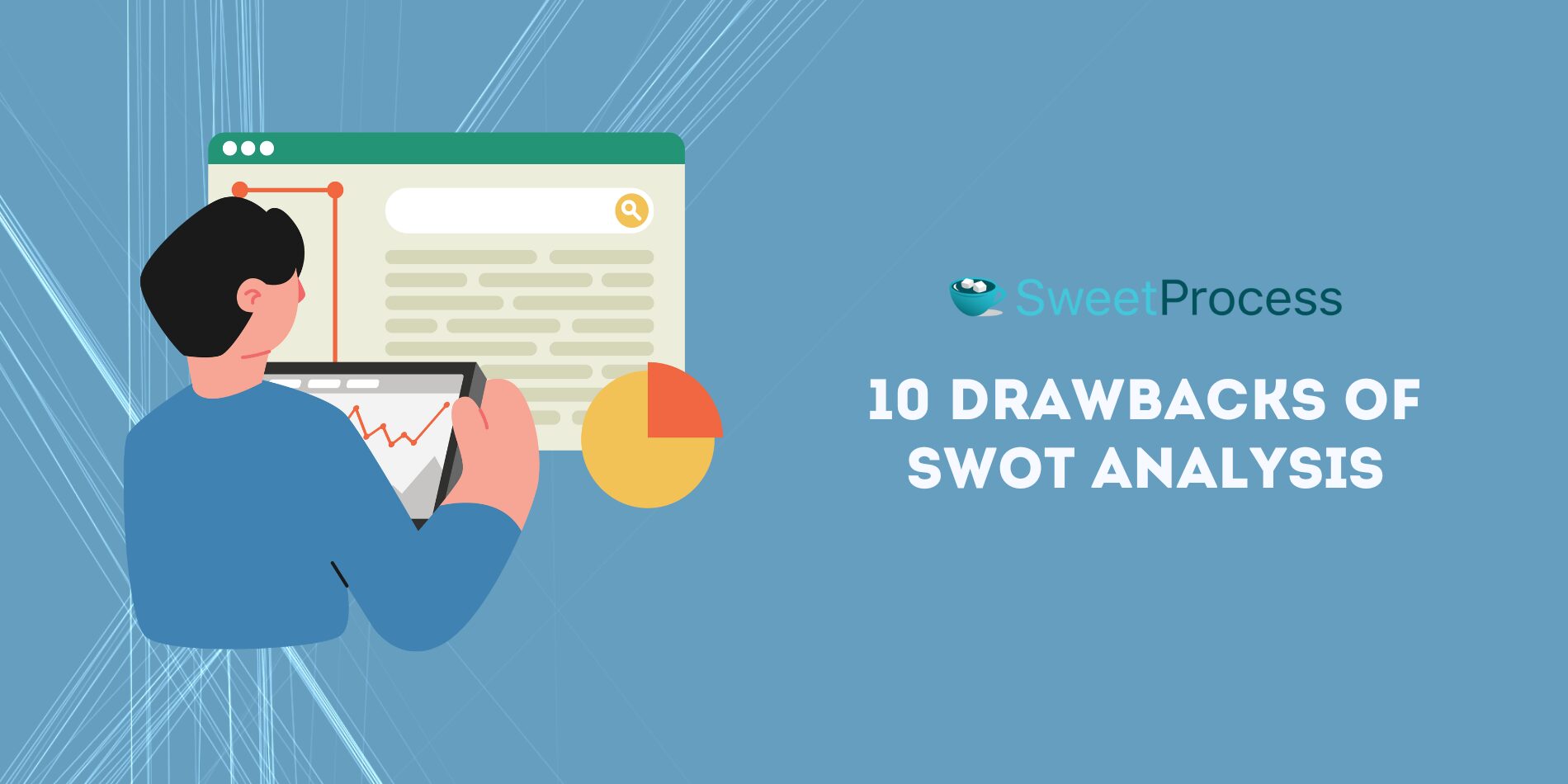
Here are ten significant drawbacks that you may encounter when using SWOT analysis:
1. Subjectivity
SWOT analysis often relies on the perspectives and opinions of the participants, which can lead to subjective conclusions. Without data-driven insights, teams might overestimate strengths or underestimate weaknesses, skewing the results.
2. Lack of Prioritization
SWOT analysis results in a list of strengths, weaknesses, opportunities, and threats without providing a mechanism to rank their significance.
This lack of prioritization can make it challenging to determine which factors are most critical and should be addressed first.
3. Oversimplification
SWOT analysis can sometimes oversimplify complex business environments. While it provides a snapshot of internal and external factors, it may not offer insights into the nuances of competitive dynamics, market trends, or consumer behavior.
4. Limited Focus on Implementation
While SWOT analysis helps identify what needs to be addressed, it doesn’t provide a clear action plan or implementation strategy. This leaves businesses with a list of factors but no guidance on how to act on them.
5. Snapshot in Time
SWOT analysis captures a moment in time and is often based on the current situation of the business and its market environment. However, industries and external factors can change rapidly. Relying on insights from a single SWOT analysis without regular updates can lead to outdated strategies and poor decision-making in a dynamic market.
6. Overemphasis on External Factors
Teams often focus heavily on external opportunities and threats, neglecting internal factors. This imbalance can lead to underdeveloped strategies that don’t address core weaknesses or leverage existing strengths.
7. Groupthink
SWOT analysis can be susceptible to groupthink when it is performed in a group setting. This phenomenon occurs when groups tend to coalesce around the opinions of a powerful leader, potentially stifling diverse perspectives and critical thinking. Groupthink can lead to overlooking important factors or reinforcing existing biases.
8. Failure to Act on Findings
Even the most comprehensive SWOT analysis is useless if businesses fail to act on the findings. Without follow-up actions, insights remain theoretical and don’t translate into measurable outcomes.
9. Lack of Numerical Data
SWOT analysis often relies on qualitative assessments rather than quantitative data. This can make it difficult to measure the actual impact of identified factors or to compare them objectively. Without numerical data, it may be challenging to make data-driven decisions or to track progress over time.
10. Lack of Existing Processes
Despite being a seemingly simple framework, most businesses lack an internal process for performing effective SWOT analysis with any regularity. This lack of established procedures can make it challenging to conduct SWOT analyses consistently and efficiently, potentially reducing their effectiveness as a strategic tool.
Improve Your SWOT Analysis Process Using SweetProcess
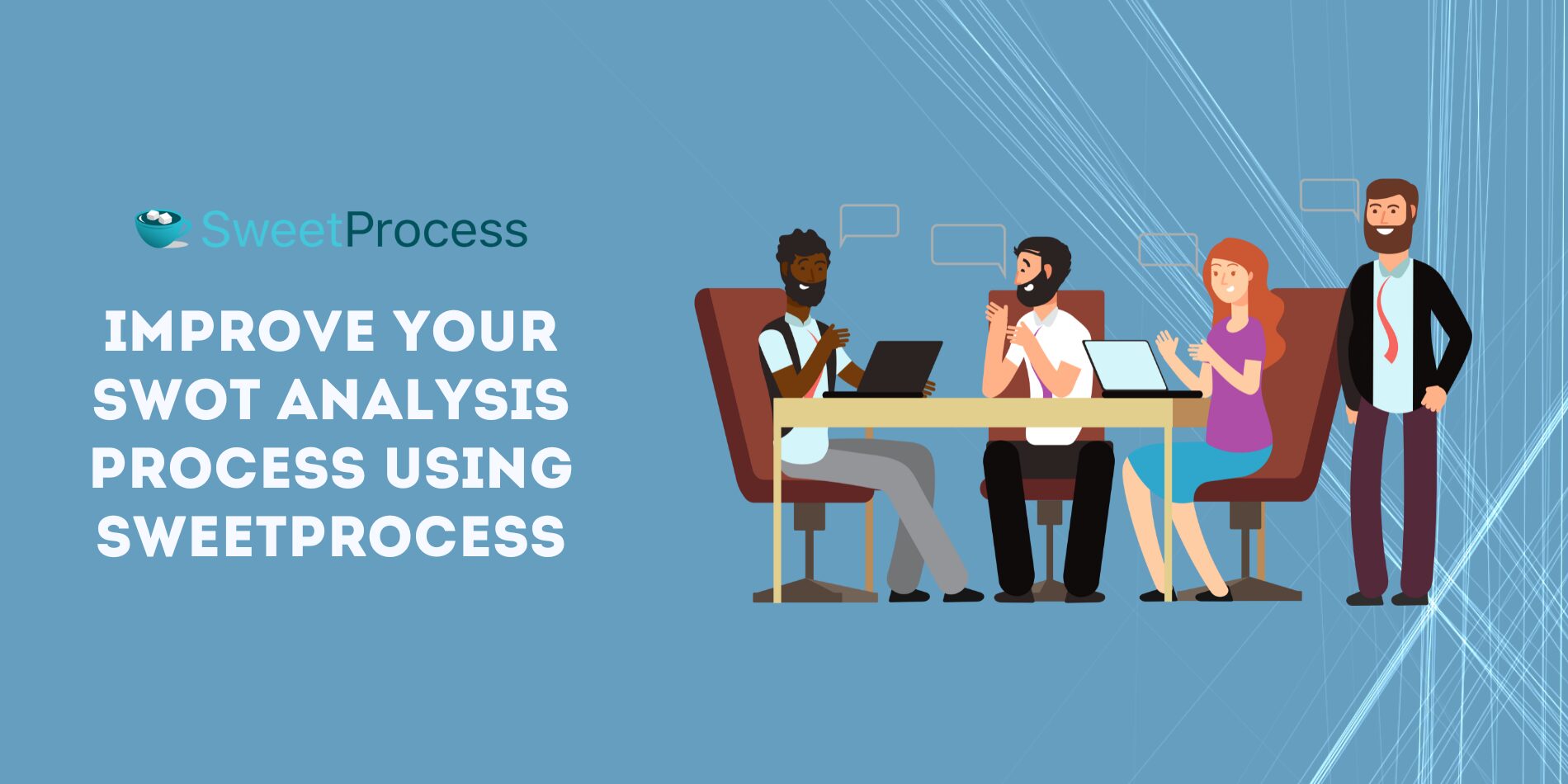
SWOT analysis is a powerful tool that is a foundation for strategic planning, helping you make informed decisions and drive growth.
However, the true value of a SWOT analysis lies in its execution.
This is where a powerful process management tool like SweetProcess becomes critical.
SweetProcess helps you transform SWOT analysis from a theoretical exercise into a practical, actionable strategy.
By integrating SweetProcess into your business processes, you can ensure your SWOT analysis is not only thorough but also actionable and effective.

